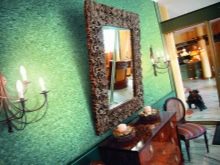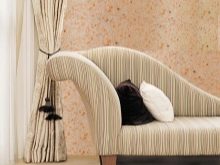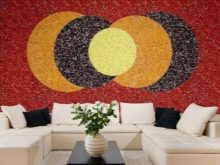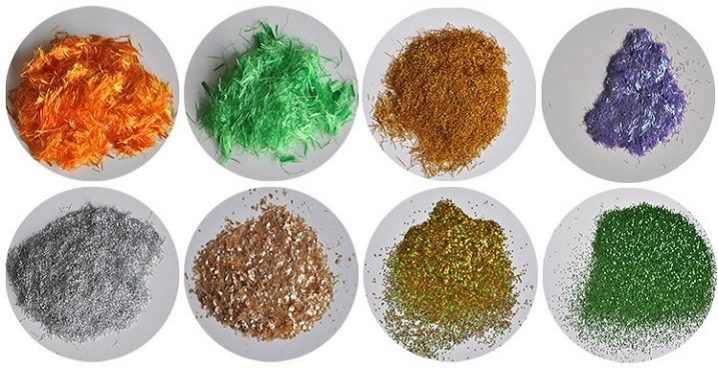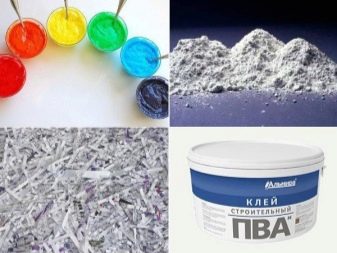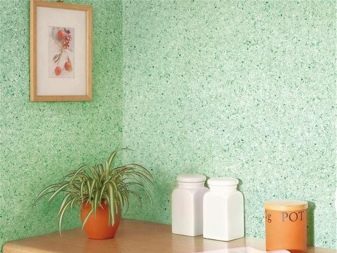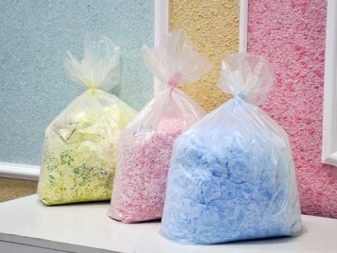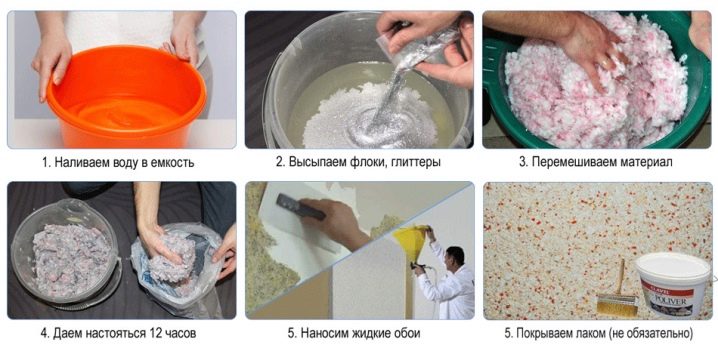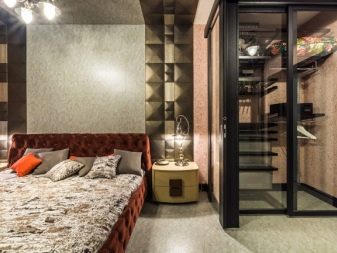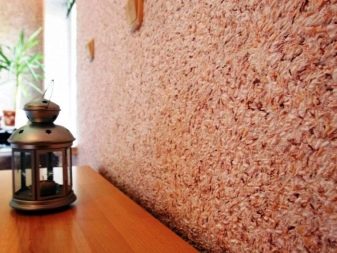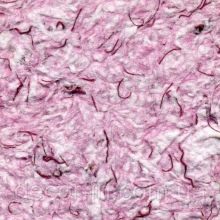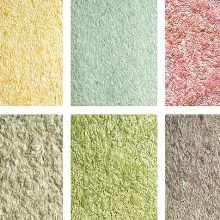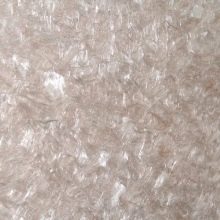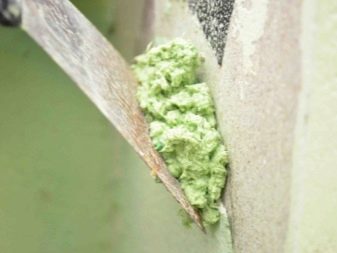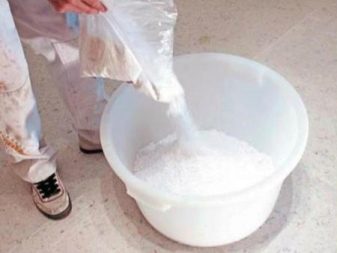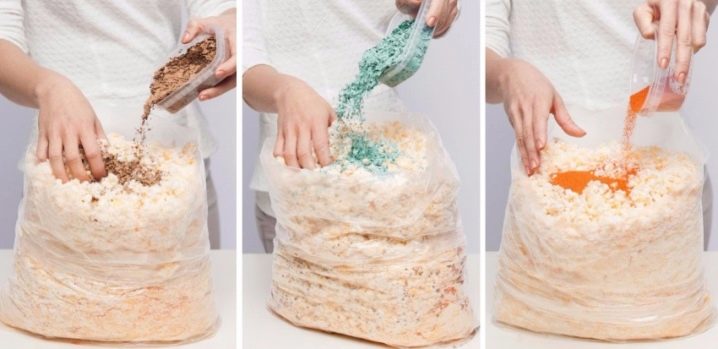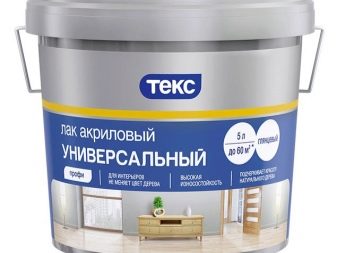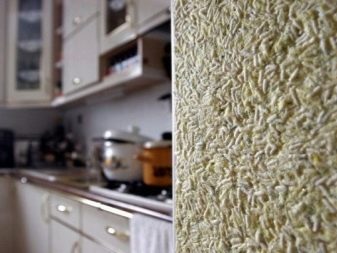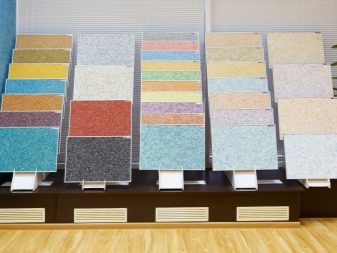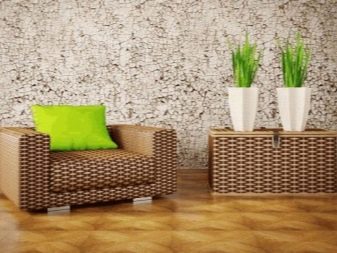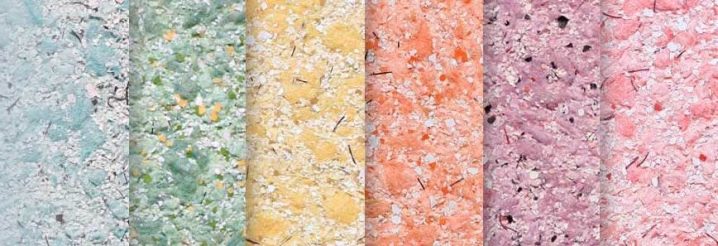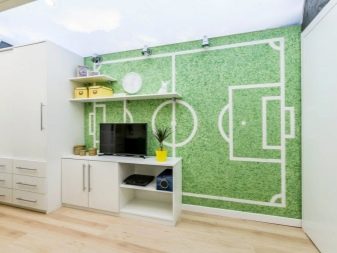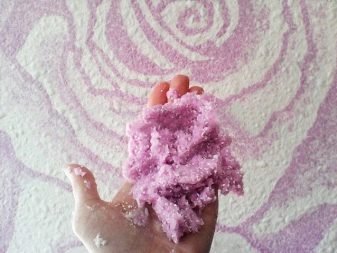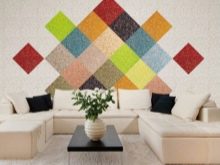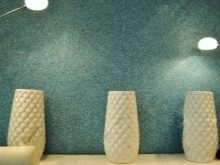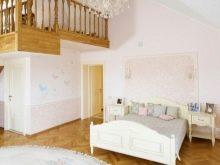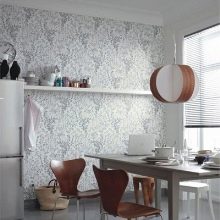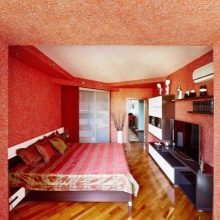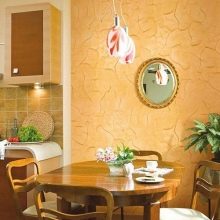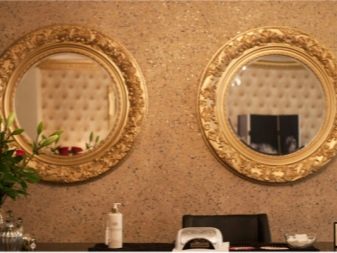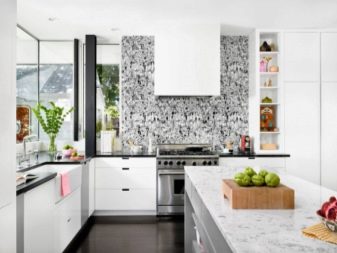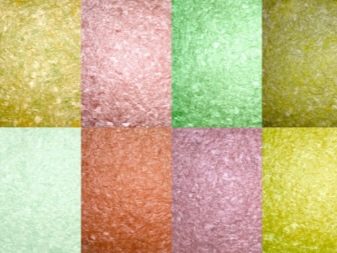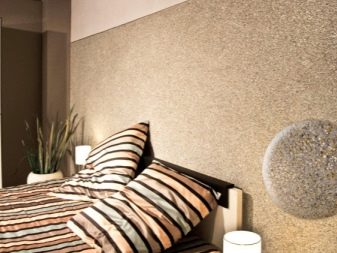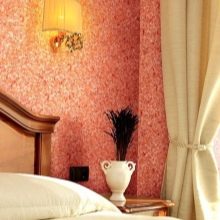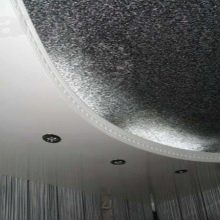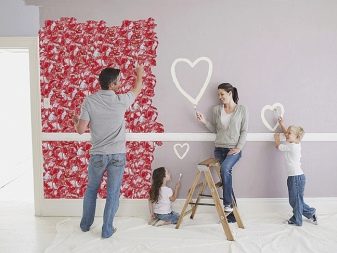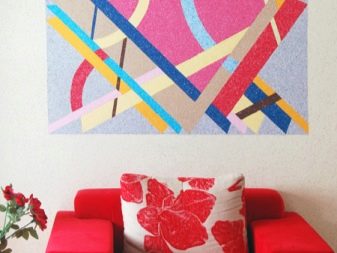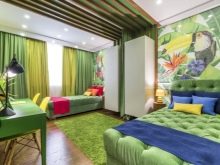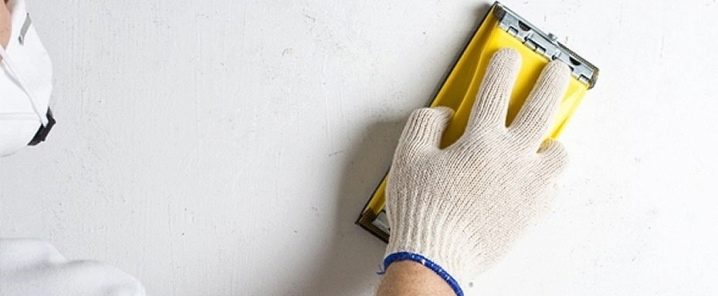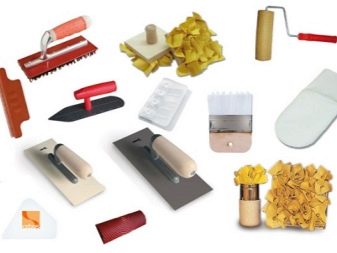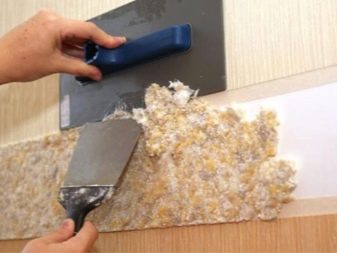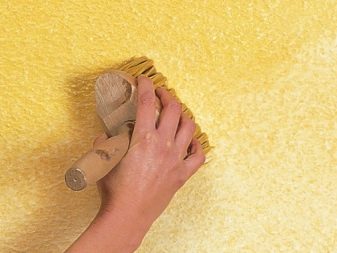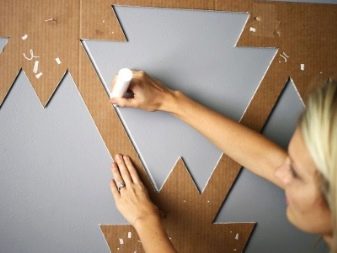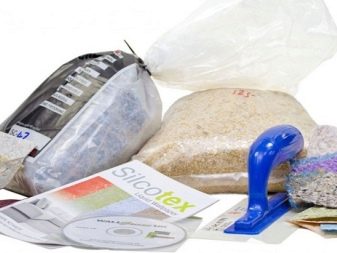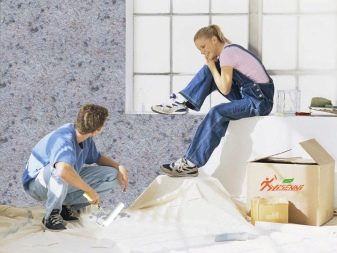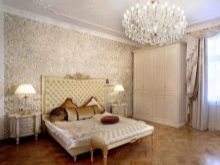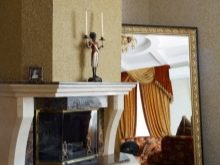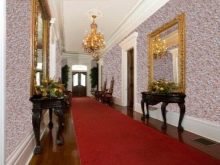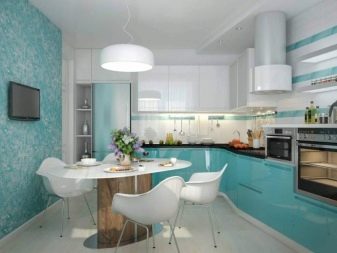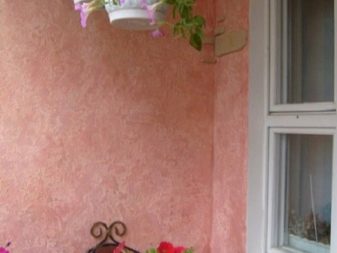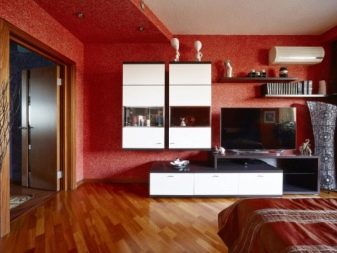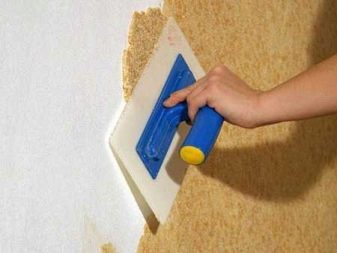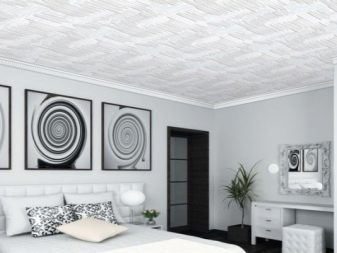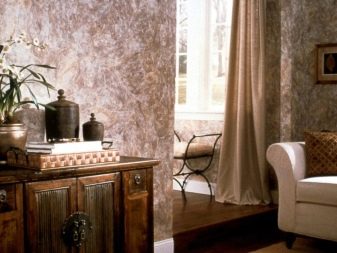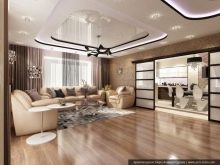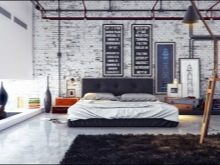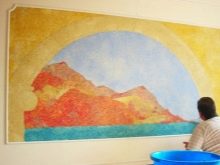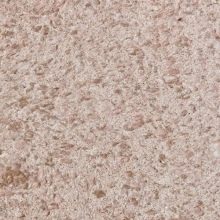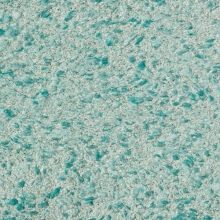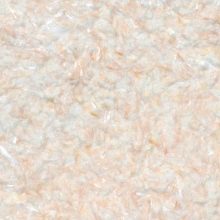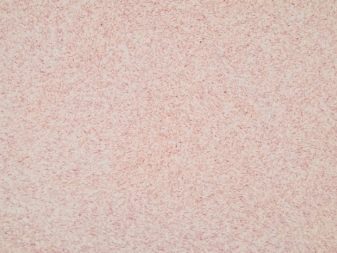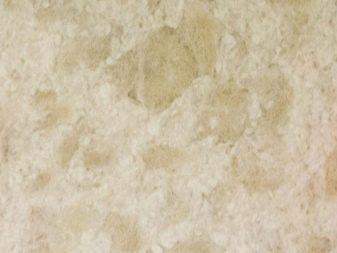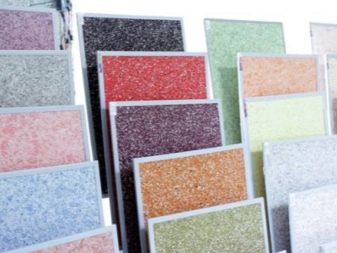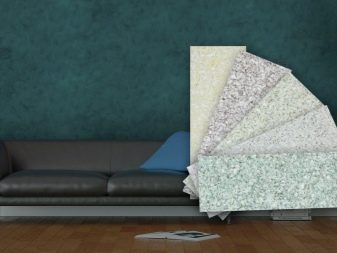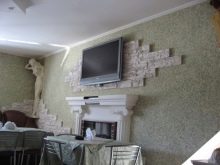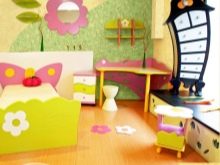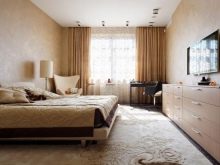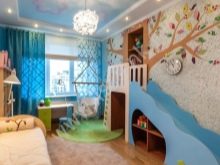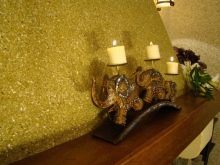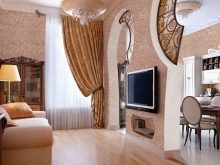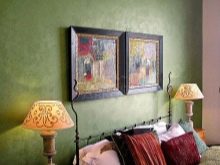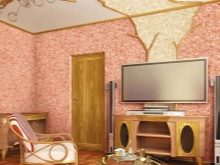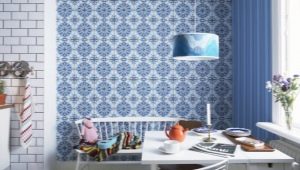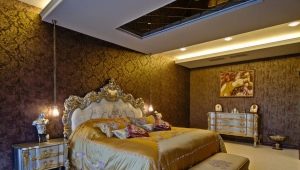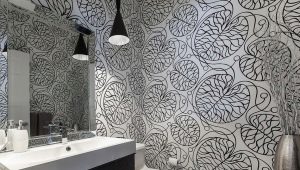Liquid wallpaper: advantages and disadvantages
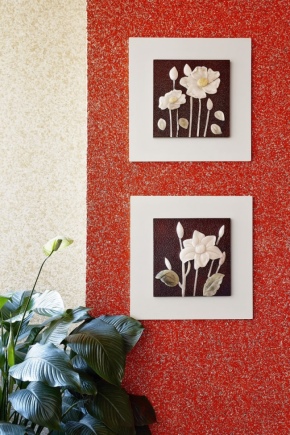
The usual wallpaper has been replaced by a new type of wall covering, which is rapidly gaining popularity among users. This coating is called liquid wallpaper. Everyone can try to decorate the walls with liquid wallpaper in his house, but it is recommended that you familiarize yourself with the types of products, selection rules and techniques for applying products to the wall before buying them.
Only with all the features, advantages and disadvantages of this technology you will create the perfect design of the walls in your apartment.
What it is?
Liquid wallpaper is a coating that includes components such as glue and cellulose.Often, the specific decoration of products uses fibers of various fabrics, as well as special dyes of various shades.
Liquid wallpaper looks like dry mix in bags that resembles material for children's handicrafts. Often, the characteristics of plaster are attributed to the products and it is said that liquid wallpaper is a mixture of classic wallpaper and plaster. The difference is that sand is a part of the latter, but it is not among the components of liquid wallpaper.
In addition to the purchase of finished products, you can easily make the cover yourself. To do this, use:
- A4 sheets of paper;
- Scissors;
- Capacity for liquid (bucket or deep basin);
- PVA glue;
- Cool water;
- Construction mixer;
- Gypsum;
- Decorative and colored items.
Sheets of paper should be cut into pieces ranging in size from 20 to 50 mm, then put them in a container and pour water so that the paper is slightly above the water surface. After letting the mixture soak a couple of hours, mix the water and paper using a mixer until smooth. Re-beat the mixture after adding color, decor, glue and plaster.
An alternative to plain paper is thick paper from newspapers. You can create your own relief from sawdust and other scrap materials.By creating a liquid wallpaper yourself, you can show your taste and personality in the design of the apartment.
Kinds
Despite the fact that liquid wallpaper and plaster have a number of common properties, wallpaper is a greater variety of coatings. The difference in the types is determined mainly by the composition and relief of the products, as well as the peculiarities of the surface on which they can be placed
The composition of the mixture may include silk fibers, cotton elements, flax particles, or even wool. Silk wallpapers are a very beautiful and durable material. They are of high quality and resistant to sunlight. Cellulose-based coating is less wear-resistant, but has a reasonable price, compared to the silk analog.
The most popular varieties of the coating, consisting of a mixture of cellulose and silk. But they are not very different in quality from ordinary cellulosic materials. Cotton products are also very popular. Cotton makes up almost 100 percent of the composition. Another component of the wallpaper is mica. Often in the composition of the wallpaper added plant fibers, mineral components and synthetic elements.
Wallpapers are different in the method of application:
- A simple option involves the dilution of the finished mixture in water. Even those who have no experience in applying a liquid composition to the walls can easily cope with the use of this technology.
- A more complex option involves a white mixture in combination with special dyes. Suitable dye must be selected separately.
According to the location of the product are divided into:
- Wall mounted;
- Ceiling.
That the wallpaper had an unusual texture, use a variety of decorative components:
- Marble chips;
- Wood chips;
- Quartz particles.
It is also worth paying attention to the types and characteristics of varnish, which can be used for additional coating of liquid wallpaper. The most suitable will be a water-based acrylic varnish. Additionally, it is better to cover walls only in rooms where there are wet marks on the walls due to moisture. For dry rooms, additional wall covering is not recommended.
You can choose among two types of varnish: matte or gloss. But remember that applying an additional layer can change the color of the wallpaper, making it more saturated or dark.
Advantages and disadvantages
For liquid wallpaper is characterized by both advantages and disadvantages in comparison with other types of coatings. It is important to consider both the positive and negative sides when choosing products so as not to encounter difficulties during operation and coating.
The main advantages of liquid wallpaper are:
- Compared with conventional wallpaper, liquid coatings do not leave any seams. They make the surface smooth, not forming joints and borders between the stripes.
- The composition of the adhesive substance wallpaper includes natural components, so it is harmless, does not cause allergic reactions and can easily be used even for children's rooms. In the process of using from the surface of the wallpaper does not emit any substances harmful to health.
- Since products can consist of many different components, they are distinguished by a huge variety of colors and textures of models.
- Liquid coatings are not exposed to temperatures. These wallpapers are ideal for rooms that are not equipped with a large number of heaters.
- These coatings do not fade in the sun. When exposed to ultraviolet rays, they do not lose their color saturation.
- The technology of applying liquid wallpaper is simple, they can also be easily removed. In the process of removal will not be as much garbage as is usually the case when removing ordinary wallpaper.
- Before applying the wallpaper there is no need to gloss over small errors of the wall surface with plaster. Liquid wallpaper perfectly mask minor irregularities without the use of additional funds.
- Due to its dense texture, these products create a noise insulating layer. The porous structure transmits fewer sounds into the room.
- In addition to saving from noise, these wallpapers also retain heat. In rooms with liquid wallpaper, the air temperature is higher than in rooms with different coatings on the walls.
- The surface of the wallpaper does not accumulate dust. Even light areas will not become darker some time after the start of operation.
- In the structure of such coatings do not multiply harmful microorganisms.
- When applied to the wall, these wallpapers do not need to be adjusted according to the parameters of the room and cut individual pieces for hard-to-reach sections of the wall, which significantly saves repair time.
- For products the material of which walls are made is not important.Pre-coating, which is a special primer, is applied only in the case of particularly problematic surfaces, so that the wallpaper subsequently lies evenly.
- When applied, you can independently create patterns on the surface.
- Under all operating conditions, liquid wallpaper can have a long service life.
- The surface, decorated with liquid wallpaper, is very pleasant to the touch due to its unusual relief and gives not only aesthetic, but also tactile pleasure.
- If the wallpaper is damaged, the damaged area can always be removed and a new mixture applied to this place.
- Coatings of this type open space for experiments with the appearance of the walls. Using this technology, you can realize your imagination and create an exclusive design in the room.
- Due to the fact that the surface of the liquid wallpaper passes air, the room will never form a stale smell or mold. Also, this property of the coating will help avoid the greenhouse effect.
The negative characteristics include the following:
- Liquid wallpaper is not suitable for use in rooms with high humidity levels.They are not very moisture resistant and can even be removed from the surface of a wall or ceiling when in contact with water.
- Cleaning the surface of products is not very easy. They can not be washed with plain water or soapy water. It is preferable to use dry cleaning methods. These include the use of special nozzles vacuum cleaner or just a dry cloth.
- Compared to traditional coatings, liquid products have a higher cost, and for finishing large rooms this option can become very expensive.
Colors and design
When choosing a liquid wallpaper, it is important to think about what colors, prints and accessories can allow these products. The palette of shades of liquid wallpaper is very wide, there are various combinations of colors.
Embossed wallpaper rarely peculiar monotony, they usually combine shades close to each other, but sometimes there are also contrasting combinations.
Beige colors are usually used as a base. They are often diluted with more saturated patterns. Sometimes this color can be seen if the wall is made in a combined design. Light stone and other textures look great in combination with a similar relief.
Close color combinations include yellow and green, peach and red, purple and pink. An example of contrasting liquid coatings would be red and black combinations. Often in the composition of such products included white patches.
Dark elements are present in the form of an additional decoration of the base color. They are shapes or patterns. A popular design is a strip that does not necessarily have lines of the same shape.
Picturesque paintings of different types are created in the rooms due to the drawings on the liquid wallpaper. With the help of relief products, you can decorate the wall with elements such as urban landscapes. Panorama of the city in the whole wall will make your room truly original. Glitter is a necessary decorative attribute in the decoration of many drawings.
Stencils are often used to apply a pattern, which can be bulk, multi-color, single-color, or anti-stencils. Gradient technology is sometimes used in the application of a liquid coating. Part of the room can be covered with wallpaper of a rich hue, but it gradually turns into a pastel color on the opposite wall.
How to apply?
The procedure for applying liquid wallpaper on the wall is nothing complicated. Repair can be easily carried out independently at home. You just need to follow a specific algorithm of actions:
- Preliminary work - cleaning walls from the remnants of old coatings and cleaning their surface from contamination.
- It is necessary to dilute the mixture in the manner indicated in the instructions or on the packaging. It is necessary to calculate the amount of material so that is enough for the entire surface of the wall.
- After the composition should be given 12 hours of time so that it is present. In some cases, in order not to form lumps in the composition, it is recommended to prevent it after the first 6 hours.
- Stir the mixture thoroughly with your hands before coating. To preserve the structure of the wallpaper, it is not recommended to use construction tools.
- Make sure that the temperature in the room is at least 15 degrees.
- Cover the wall with a metal spatula with a uniform motion. It is important not to press on the surface during installation.
- The layer should be no more than 0.5 cm thick. To avoid differences in color, use one mixture on one wall.Sometimes the composition is applied in two thin layers.
- If you want to draw a picture, then in advance make the outlines of the image on the wall with a pencil and gently apply the mixture without leaving the contours. Wall-paper applied shade usually dry for 3-4 hours, then put a different color. Consumption and distribution of material will be optimal if the areas of all colors will have the same thickness.
- After coating, the wall will dry completely for about three days.
- To increase the resistance of the walls to moisture, after drying, the wallpaper is covered with a special acrylic varnish.
An important point in the application is the material of the walls. Some surfaces still require additional processing. Such materials include hardboard, which greatly changes its shape when in contact with water.
It needs to be treated with several layers of a hydro-resistant primer, before applying the wallpaper and using an antiseptic for surface treatment.
Where are they used?
Despite the fact that such non-standard wallpapers are becoming very popular in many houses and apartments, they can not be used in all rooms.Best liquid wallpaper suitable for rooms such as bedroom, nursery, corridor and living room. They are usually moderate humidity.
In the bathroom, it is not recommended to glue any wallpaper, including products with liquid application technology. From a large amount of moisture, the coating will simply peel off the surface and last for a very short time.
The air in the kitchen is also periodically quite humid. In the process of cooking various pairs are allocated that can affect the state of the wallpaper. You can allow the presence of liquid coatings in this area, only if the kitchen is quite large. Similar wall-paper can finish a wall which will not be in direct contact with steam and moisture.
Some place liquid wallpaper on the balcony. But in this case it is necessary to observe a number of conditions. It is best to decorate the loggia with similar wallpaper, if you live in an area with a dry climate. If not, then do not keep balcony windows openso that weather conditions do not have a strong influence on the condition of the walls.
How to choose?
The main criteria for choosing a liquid wallpaper - material consumption and design features of the room.
The first criterion is very important, because if it is not taken into account, the mixture for application can end at the most inappropriate moment, and this will significantly prolong the repair process. Consumption must also be taken into account in order to calculate in advance the amount that will cost the wall or ceiling decoration.
To calculate the flow, you need:
- Measure the area of the entire surface on which the wallpaper will be applied. For this, the area of the walls is minus the area of door and window openings.
- Pay attention to the condition of the walls. Surfaces with irregularities may require a greater amount of material.
- Look at the flow tables available on each mix pack.
- Be sure to stir the material very carefully, because the lumps are more difficult to spread over the surface.
- A less economical factor is the loss of a mixture of elasticity. It occurs as a result of overexposure.
- Do not overdo the addition of water. If there is an excess of moisture in the mixture, the material will begin to slide off, and this will affect the flow rate.
Considering all the factors, you will be able to choose the desired wallpaper, while saving money, time and effort.
Liquid wallpaper is beautiful suitable for any direction of the interior. But the question arises, which wall design is right to choose, so as not to disturb the style in which the room is decorated.
On the ceiling is usually applied liquid wallpaper of light colors. If the surface of the ceiling is embossed, then on its protruding parts sometimes brighter shades, echoing the color of the walls, are chosen. This accent is characteristic of the Provence style. On the walls should be a bright wallpaper with pastel blotches - green, pink, blue or lilac. The concept should be light and airy.
Natural colors for embossed wallpapers, such as beige or green, will perfectly fit into the idea of ecological style. The classic style with embossed walls and grooves will look great with creamy tones of liquid wallpaper, “diluting” the recessed section of the wall.
For styles country and loft You can choose a wallpaper that mimics the brickwork. They will vividly reflect the concept and complement the interior in an original way. For the Art Nouveau style, geometric relief and bright monochromatic colors are often chosen.
Hall - the most suitable place to create a panel on the wall.An interesting element created with the help of liquid wallpaper will always attract the eyes of your guests.
Manufacturers
The company that produces liquid wallpaper, determines many of the attributes of the product, especially the price and quality. There are a number of popular companies that have successfully established themselves in the building materials market.
Silk plaster - Russian company that provides a rich selection of decorative elements and a huge palette of colors. Wallpapers perfectly mask the imperfections of the wall relief, as well as resistant to UV rays. Especially noteworthy is the collection "Victoria"which presents high silk fiber wallpapers. A popular shade is Optima 058 - neutral beige tone with a peach pattern, which is perfect for any style of interior.
Production of wallpaper for major developers is carried out by the company. Master Silk. The company's products are famous for their affordable prices. It provides a wide range of wallpapers that provide excellent heat and sound insulation, as well as made from a special non-combustible material.Products of this company are often chosen to repair apartments in new buildings.
The French company has become a favorite to many companies producing both smooth and embossed coatings. "Leroy Merlin". These wallpapers are characterized by high elasticity and a very easy application system.
Trademark "Bioplast" produces only products with relief. They are very easy to repair, have a high air conductivity and perfectly repel pollution.
Each of the firms has its strengths, which many consumers have already seen. Therefore, choosing products from any company, you will provide yourself with quality material that will serve you for many years.
Beautiful options in the interior
There are various design solutions to make liquid wallpapers as unusual and interesting as possible. both in non-standard apartments and in ordinary apartments:
- In the living room, products are often combined with other coatings that mimic natural textures, such as stone or wood.
- In the bedroom or the nursery, a similar covering of the walls can be embodied in a beautiful ensemble with textiles.The comfort of the room will give the use of models with silk elements that will create an elegant outflow.
- For the child can be done with the help of liquid wallpaper colorful pattern on the wall.
- To create an original interior design when mixed in the wallpaper add glitter or fluorescent paint, creating a stunning sheen on the wall.
- Liquid wallpaper is not always applied to all the walls in the room. They can play an accent role and be located only on one wall. They should be combined in color with the rest of the walls, but stand out among them with their unusual texture.
- With a coating of the mixture fill areas on the relief wall, for example, in the space under the arch.
The obvious fact is that liquid wallpaper have much more positives than negative. Feel free to choose such products for the design of their apartments. Looking at the original appearance of the walls, you will get aesthetic pleasure and feel the joy of being at home.
For how to apply liquid wallpaper on the wall, see the next video.
